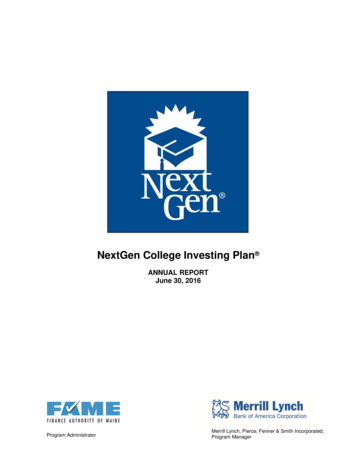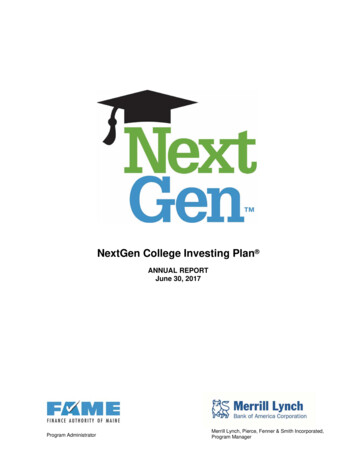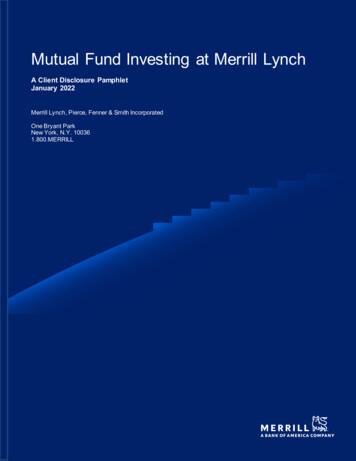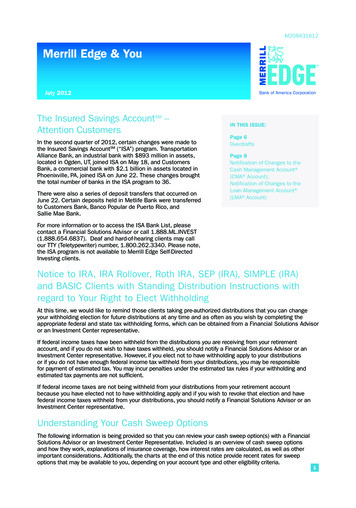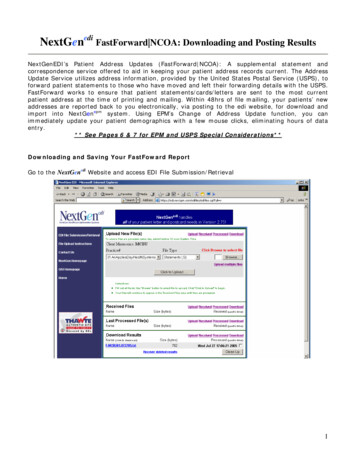
Transcription
NextGen CollegeInvesting Plan An investment for a lifetimeof achievement
An investment for a lifetime ofachievement. begins today“Education is the soul of asociety as it passes from onegeneration to another.”G.K. Chesterton,Late British authorMerrill Lynch Wealth Management makes available products and services offered by Merrill Lynch, Pierce, Fenner & Smith Incorporated (“MLPF&S”), a registeredbroker-dealer and member SIPC, and other subsidiaries of Bank of America Corporation (“BAC”).Investment products:Are Not FDIC InsuredAre Not Bank Guaranteed2May Lose Value
Giving future generations an opportunityto succeedTime flies. Before you know it, the next generation will be in charge of shaping our local, national andinternational communities. Your children will be out there, forging ahead in a fast-changing, complex andcompetitive world.As parents or grandparents, you want to give your family’s next generationevery opportunity to be happy, productive and successful.One of the best advantages you can provide for them is the gift of highereducation. Think of it as an investment for a lifetime of achievement.Determining the appropriate steps and starting as soon as possible can giveyour children or grandchildren the resources they need to attend college orgraduate school. Consider the Merrill Lynch NextGen College Investing Plan when determining the right steps for you.It’s a way for you to invest in the future of your children—the next generation.In this brochure, we’ll discuss: The rising cost of a college education. The lifelong benefits and rewards of a college degree. Benefits and features of the NextGen plan. Professional investment management options. Frequently asked questions.NextGen is a nationally offered Section 529 plan sponsored by the state of Maine andadministered by the Finance Authority of Maine. Merrill Lynch, Pierce, Fenner & SmithIncorporated is the program manager, underwriter and distributor of the plan.3
The rising cost of a college educationThe basic yearly costs of attending college—tuition, room andboard, fees and books—have increased dramatically over thelast two decades. During this period, average annual increases incollege costs have exceeded annual inflation rates (as measured bythe Consumer Price Index) almost every year.Everyone knows that sending your children to a private high school, collegeor graduate school is expensive. But look at how quickly the cost of collegeeducation is rising.If your children are very young and will enter college 10, 15 or 18 yearsfrom now, the total costs are estimated to be even higher. By 2031, the CollegeBoard estimates that the cost of attending college for four years will be 267,801 at an in-state public institution and 527,236 at a private institution.FOUR-YEAR COST OF COLLEGE IS GOING UPProjected four-year costs at an in-state public and a private college today and in 18 years.Costs projected to escalate at 6% per year.2013 99,452Public College20312013 267,801 195,797Private College 527,2362031Source: www.collegeboard.com. College Cost Calculator as of October 20134
The lifelong benefits and rewards of acollege degreeDespite the substantial costs, a college degree really pays off.“Higher educationis an investmentin human capital.”According to a 2013 survey conducted by the U.S. Bureau of Labor Statistics,a person with a bachelor’s degree earned on average 70 percent more thana typical high school graduate. Someone with an advanced degree made 26percent more than someone with a bachelor’s degree. As the chart belowdemonstrates, higher education equates to higher earnings potential.Katherine Haley WillPresident, Gettysburg CollegeAnd according to the College Board, college graduates and graduate degreeholders receive significant intangible benefits and rewards compared with highschool graduates: Enjoy better employee benefits. More likely to vote and take an interest in their communities. Exhibit better health-related behavior patterns.Experts believe the earnings gap will widen as mature economies look to science,technology and research to generate growth and jobs. In short, the value of highereducation is increasing as knowledge-based industries expand.A COLLEGE DEGREE LEADS TO HIGHER INCOMEMedian weekly earnings (dollars)Advanced degree 1,387 1,101Bachelor’s degree 751Associate degree 647High-school graduateNot High-schoolgraduate 477Source: Bureau of Labor Statistics, www.bls.gov.5Usual weekly earnings of wage andsalary workers second quarter 2013.
Benefits and features of the NextGen planToday’s cost of higher education is significant for most families, particularly if several children aredestined for college. Most parents use a combination of sources to manage and fund the costs,including financial aid such as grants, scholarships, personal loans and savings. NextGen can help youwith your college funding goals.The NextGen College Investing Plan offers certain tax andfinancial benefits and a variety of versatile features to helpyou invest for future higher education expenses.your federal unified estate tax credit. For contributionsbetween 14,000 and 70,000 made in one year, if theaccount owner dies before the end of the five-year period, aprorated portion of the contribution may be included in his orher taxable estate.Tax advantagesTax-deferred earnings growth potential: Any earningson NextGen investments have the potential to grow freefrom federal (and possibly state) income taxes, allowing youraccount assets to potentially grow and accumulate fasterthan in taxable investment accounts.Grandparents take note. By funding accounts for severalgrandchildren, this special election can be a useful tool toefficiently manage the size of your estate while leaving alasting legacy for your loved ones.State-tax benefits: Certain states may offer tax or otherbenefits for investing in their Section 529 plan. Some statesmay reduce or eliminate those benefits for investments inSection 529 plans administered by a state other than yourhome state or your beneficiary’s home state. It is importantto carefully consider any benefits available in your homestate (or the home state of your designated beneficiary),along with a plan’s investment manager, investment options,plan performance and underlying fees and expenses prior toinvesting. Certain states also may require the recapture of allor part of previously claimed tax benefits if the proceeds arenot used for qualified higher education expenses (as definedby the federal tax law) or if the assets are transferred toanother state’s Section 529 plan.Tax-free withdrawals: Any earnings generated willbe federal (and possibly state) income tax-free as longas withdrawals are used for qualified higher educationexpenses (like tuition, room and board, and otherexpenses).1,2 Any earnings withdrawn that are not used forsuch expenses are subject to federal income tax and a 10percent additional federal tax, as well as applicable stateand local income taxes. The additional tax is waived undercertain circumstances.No federal gift tax: You can make annual contributionsof up to 14,000 ( 28,000 for a married couple) withoutincurring a federal gift tax. Contributions to plan accountsare considered completed gifts and are excluded from yourestate for federal estate tax purposes, even though you (theaccount owner) retain control of the account assets.Qualified and nonqualified expensesBroad definition of qualified expenses: As mentionedearlier, withdrawals from your NextGen plan account arefree from federal (and possibly state) income tax if theyare used to pay for qualified higher education expenses ataccredited post-secondary schools.4 These expenses include:Estate tax management: Under a special five-year giftrule, you may be eligible to make a special gift-tax electionand make NextGen account contributions of 70,000( 140,000 for a married couple) for each beneficiary in oneyear, and elect to prorate it over five years, as long as noadditional contributions or other gifts to the designatedbeneficiary are made during the five-year period.3 Thiselection generally will not incur a gift tax liability or reduce Tuition, fees, books, supplies and equipment required forenrollment or attendance of the designated beneficiary atan eligible institution.6
Keep control: A NextGen account owner retains legalcontrol and may change the beneficiary to other familymembers of the original beneficiary at any time without anytax consequences.5 Room and board.2 Certain expenses for services of a designated beneficiarywith special learning or disability needs.Any earnings withdrawn that are not used for such expensesare subject to federal income tax and a 10 percent additionalfederal tax, as well as state and local income taxes. The 10percent additional tax on nonqualified withdrawals is waivedunder the following conditions:High contribution limit: The NextGen contribution limit is 380,000 per beneficiary.Convenient investing: You can conveniently depositautomated bank transfers or payroll deductions into aNextGen account. If the beneficiary receives a scholarship or attends amilitary academy, you can withdraw up to the amountof the scholarship or the value of the attendance at themilitary academy.Professional management: A wide array ofprofessionally managed investment options is available(see next page for details). If the beneficiary becomes disabled.Increased savings from tax-free growth If the beneficiary dies and the withdrawal is paid to thebeneficiary’s estate.Tax exemption and compounding: Over time, the valueof an investment account, such as NextGen, that is taxfree will exceed the value of a taxable investment account(see example below for details). If you also consider thecompounding effect that occurs in a tax-free account, youwill see that you potentially can accumulate assets fasterthan in a taxable account.Versatile featuresBroad definition of account owners: Anyone age 18 orolder with a valid social security number or U.S. taxpayeridentification number can open a NextGen account. Sograndparents, parents, aunts, uncles and even family friendscan establish accounts. There are no income limitations.Broad definition of beneficiaries: Children, grandchildren,nieces, nephews, spouses—even non-relatives and yourself—can be named as beneficiaries.TAX-FREE GROWTH MAKES A BIG DIFFERENCEIt does not take into account the fees or expensesassociated with either the Section 529 plan orinvesting outside the Section 529 plan. 400,000Section 529 plan account350,000 363,790 67,182Taxable account300,000Account BalanceFor both accounts, this chart assumes a 7% rateof return, compounded annually, and that 10,000is invested in each on January 1 every year for 18years. For the Section 529 plan account, earningsare not taxed. For the taxable account, earnings aretaxed at 28%. This chart is illustrative only. It doesnot reflect an actual investment in the NextGenplan. Investments are subject to market and otherinvestment risks. Returns are not guaranteed andmay be less than or more than the amount invested.250,000 296,608200,000150,000100,00050,0000Source: Merrill Lynch7123456789 10 11 12 13 14 15 16 17 18Years
Professional investment management optionsWhat distinguishes the NextGen plan from other Section 529 plans is its array of investment choices.The NextGen Client Select Series offers a variety of investment options.Age-Based Diversified Portfolios: These portfoliosprovide an investment strategy that varies based on theage of the child and when the child is expected to needthe assets for higher education expenses. Funds areinvested most aggressively when the child is young and areautomatically shifted to more conservative investments asthe child approaches college age. Selecting an age-basedportfolio may be appropriate if you prefer not to activelymanage the investments.6NextGen Savings Portfolio: This portfolio is comprisedexclusively of an interest-bearing FDIC-insured bankaccount (the “Bank Deposit Account”) at Bank ofAmerica, N.A. (the “Bank”), and is designed as an optionfor investors whose primary objective is protection ofprincipal. The NextGen Savings Portfolio offers FDICinsurance up to 250,0007 combined with the flexibilityand benefits of a tax-advantaged Section 529 account.You may want to consider this portfolio if you are seekingpreservation of assets and liquidity, or if you are nearingthe time you will need to pay for qualified highereducation expenses.Diversified Portfolios: These portfolios have specificinvestment objectives, such as growth or income. Unlike theAge-Based Diversified Portfolios, each Diversified Portfoliohas a consistent allocation that does not change over time.These portfolios allow you to help build a strategy bestsuited to your investment needs.Principal Plus Portfolio: This portfolio may invest inone or more guaranteed investment contracts issuedby one or more insurance companies, corporate fixedincome investments and/or similar instruments andmay make deposits to the Bank Deposit Account.7 ThePrincipal Plus Portfolio may be an option to consider ifyou have a lower risk tolerance or a short time horizonbefore paying for college.Single Fund Portfolios: These portfolios invest in oneunderlying investment, allowing you to customize yourallocations based on the range of underlying investments.They may be appropriate if you prefer a hands-on approachand want to customize an asset allocation with the selectedinvestment portfolio.Please remember there’s always the potential oflosing money when you invest in securities.8
Frequently asked questionsQ: What are some of the differences between Section529 plans (like NextGen), Coverdell Education SavingsAccounts (ESAs) and Uniform Gift/Transfers to MinorsAct (UGMA/UTMA) accounts?example, any earnings are federal (and possibly state)income tax-free upon withdrawal as long as the withdrawnamounts are used for qualified higher education expenses,improved federal financial aid treatment of the assets fora dependent beneficiary and elimination of the need to filean annual tax return for the UGMA/UTMA assets in futureyears. Because you may contribute only cash to a NextGenaccount, you will need to liquidate the UGMA/UTMA assets,and you may have a capital gains tax liability. When fundinga Section 529 plan with these assets, the owner of theUGMA/UTMA account loses control of the funds once thebeneficiary reaches the age of majority. Before initiatingthis strategy, you should consider any potential tax andlegal consequences, as well as expenses and sales chargesassociated with selling an investment and buying a new one.Talk to your Merrill Lynch Financial Advisor and your tax andlegal advisors to learn more and to determine whether thisstrategy is appropriate for you.A: Several distinctions exist between these savings andinvesting vehicles. Like a Section 529 plan, any earningsfrom a Coverdell ESA are free of federal (and possiblystate) income tax if withdrawals are used for qualifiededucation expenses.8 However, the maximum contributionto a Coverdell ESA is 2,000 per beneficiary per year, andyou can make contributions until the beneficiary is 18. Themaximum contribution for Section 529 plans is higher.Another key difference is that your ability to make Coverdellcontributions phases out at certain income levels. If singleor joint filers exceed a specified amount of income, theymay not make Coverdell contributions. Section 529 planshave no income limitations.UGMA/UTMA accounts also have no contribution limitsbut are subject to the annual gift exclusion. UGMA/UTMAcontributions become the property of the beneficiary, whomay assume total control of the account upon reaching theage of majority (typically age 18 or 21). Contributions toSection 529 plans are owned and controlled by the accountowner, not the beneficiary.Q: Are the assets in a NextGen account forfeited if thebeneficiary decides not to attend college?A: No. The account owner can designate anotherbeneficiary, close the account or keep the account open incase the beneficiary decides to attend college later.5Q: How do I balance my education savings goals withmy other financial objectives and obligations?In most cases, a Section 529 plan account owner maychange the beneficiary without any tax consequences andalso can close the account, although not using the earningsin the account for qualified higher education expenses willresult in those earnings being subject to income tax andpossibly the 10 percent additional federal tax, along withapplicable state and local tax.A: When you’re working with a Merrill LynchFinancial Advisor, he or she can help you make informeddecisions about which education funding strategies workbest for you considering your unique financial situation.We can help you make decisions about your savings inthe context of your liquidity, retirement plan, estate plan,portfolio investing and day-to-day cash management.Q: Can I use UGMA/UTMA account assets to fund aNextGen account?A: Yes. This is a popular planning strategy for manyparents and grandparents. By using these assets to funda NextGen account, you may realize several benefits. For9
Call your Merrill Lynch Financial AdvisorFree college planning analysisCall your Merrill Lynch Financial Advisorfor your free college planning analysisthat will analyze how much college maycost and how much you should considerinvesting to help meet these expenses.Your Financial Advisor can help you usethis information to decide whether theNextGen plan is the right educationfunding vehicle for you and your family.“Genius without education is like silver in the mine.”Benjamin Franklin,American statesman10
Work with your Merrill Lynch Financial Advisor tohelp you achieve your education funding goals.Visit www.wealthmanagement.ml.com,call 1.800.MERRILL or call your Merrill LynchFinancial Advisor today.11
The NextGen Plan is a Section 529 plan administered by the Finance Authority of Maine. Before you invest in theNextGen plan, request a NextGen College Investing Plan Program Description from your Merrill Lynch FinancialAdvisor and read it carefully. The Program Description contains more complete information, including investmentobjectives, charges, expenses and risks of investing in the NextGen plan, which you should carefully consider beforeinvesting. You also should consider whether your home state or your designated beneficiary’s home state offers anystate tax or other benefits that are only available for investments in such state’s 529 plan. Section 529 plans arenot guaranteed by any state or federal agency, however, the portion of the underlying deposits in the Bank DepositAccount that is attributable to the Units held by a Participant in the NextGen Savings Portfolio or the PrincipalPlus Portfolio is eligible for FDIC insurance coverage of up to 250,000 per Participant, subject to applicable limits.Merrill Lynch, Pierce, Fenner & Smith Incorporated is the program manager, underwriter and distributor.Merrill Lynch and its representatives do not provide tax, accounting or legal advice. Any tax statements containedherein were not intended or written to be used, and cannot be used, for the purpose of avoiding U.S. federal, stateor local tax penalties. Please consult your own independent tax or legal advisor as to any tax, accounting or legalstatements made herein.1 o be eligible for favorable tax treatment afforded to any earnings portion of withdrawals from Section 529 accounts, such withdrawals must be used forT“qualified higher education expenses,” as defined in the Internal Revenue Code. Any earnings withdrawn that are not used for such expenses are subject tofederal income tax and may be subject to a 10% additional federal tax, as well as applicable state and local income taxes.2The beneficiary must be attending an accredited institution at least half time for room and board to be considered an eligible expense.3 ontributions during 2013 between 14,000 and 70,000 ( 28,000 and 140,000 for married couples filing jointly) made in one year can be prorated overCa five-year period without subjecting you to gift tax or reducing your federal unified estate and gift tax credit. If you contribute less than the 70,000( 140,000 for married couples filing jointly) maximum, additional contributions can be made without you being subject to federal gift tax, up to a proratedlevel of 14,000 ( 28,000 for married couples filing jointly) per year. Gift taxation may result if a contribution exceeds the available annual gift taxexclusion amount remaining for a given beneficiary in the year of contribution. For contributions between 14,000 and 70,000 ( 28,000 and 140,000for married couples filing jointly) made in one year, if the account owner dies before the end of the five-year period, a prorated portion of the contributionmay be included in his or her estate for estate tax purposes. For information on 2014 contributions, please ask your Merrill Lynch Financial Advisor.4Institutions must be eligible to participate in federal student financial aid programs. Some foreign institutions are eligible.5Y ou are generally permitted to change the beneficiary to another member of the family (as defined under the Internal Revenue Code) without triggeringincome tax and 10% additional tax.6 T here can be no assurance that the strategy of any portfolio will be successful.7 he portion of the underlying deposits in the Bank Deposit Account that is attributable to the Units held by a Participant in the NextGen Savings Portfolio orTthe Principal Plus Portfolio is (a) eligible for FDIC insurance coverage of up to 250,000 per Participant (calculated on a basis which aggregates that portion ofthe underlying deposits attributable to the Units held by the Participant in the NextGen Savings Portfolio or the Principal Plus Portfolio with all FDIC-insuredassets held by the Participant at the Bank) and (b) for purposes of FDIC insurance coverage only, considered to be held in the same ownership capacity asa Participant’s other single ownership accounts held at the Bank. However, neither Units of the NextGen Savings Portfolio nor the Principal Plus Portfolioare insured or guaranteed by the FDIC or any other agency of state or federal government, FAME, the Bank or the Program Manager, nor does a Participanthave a direct beneficial interest or the rights of an owner in the underlying deposits in the Bank Deposit Account. Participants are responsible for monitoringthe aggregated value of the portion of the underlying deposits of the NextGen Savings Portfolio or the Principal Plus Portfolio attributable to the Units ofsuch Portfolios held by a Participant plus their other deposits held directly with the Bank, for purposes of the 250,000 FDIC insurance coverage limit. Thepercentage of the Principal Plus Portfolio that is invested in the Bank Deposit Account as of the end of each month will be posted on www.nextgenplan.com/performance.html within ten business days of month-end. Deposits held in different ownership capacities, as provided in the FDIC rules, are insuredseparately. UGMA/UTMA Accounts are generally treated as assets of the Designated Beneficiary, and other types of trust Accounts may be treated as assetsof the trustee, for purposes of the FDIC limit. Custodians of UGMA/UTMA Accounts and trustees of trust Accounts should consider how these assets will betreated for purposes of the FDIC limit. For more information, please visit www.fdic.gov.8 o be eligible for favorable tax treatment afforded to any earnings portion of withdrawals from Coverdell ESAs, withdrawals must be used for “qualifiedThigher education expenses” or “qualified elementary and secondary education expenses,” as defined in the Internal Revenue Code. Any earnings withdrawnthat are not used for such expenses are subject to federal income tax and may be subject to a 10% additional federal tax as well as state and localincome taxes.The CollegeInvesting Plan forthe Next Generation Program AdministratorMerrill Lynch, Pierce, Fenner & SmithIncorporated, Program ManagerMerrill Lynch Wealth Management and the Bull Symbol are registered trademarks of Bank of America Corporation.NextGen, NextGen College Investing Plan and The College Investing Plan for the Next Generation are registered trademarks of theFinance Authority of Maine. 2013 Bank of America Corporation. All rights reserved. I ARPMHEDU I 334202PM-1113
The NextGen College Investing Plan offers certain tax and financial benefits and a variety of versatile features to help you invest for future higher education expenses. Tax advantages Tax-deferred earnings growth potential: Any earnings on NextGen investments have the potential to grow free
